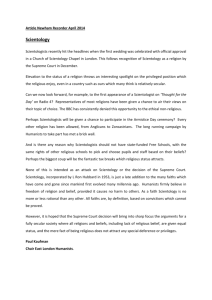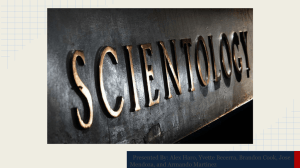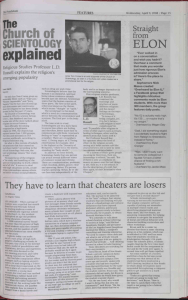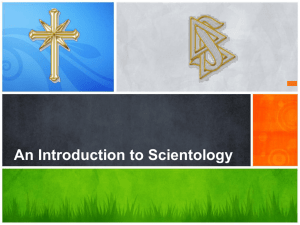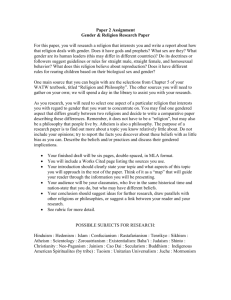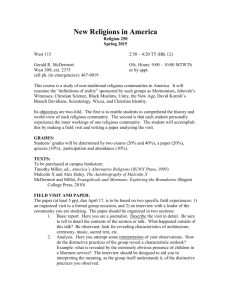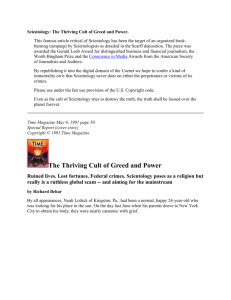IS SCIENTOLOGY A RELIGION?
advertisement
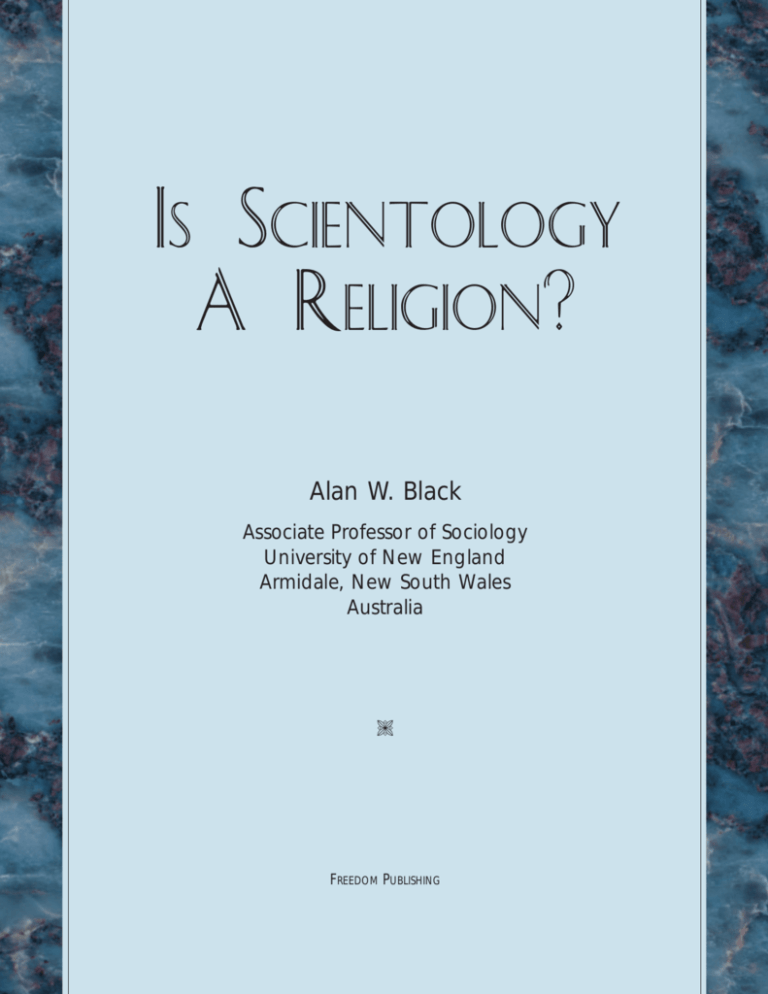
IS SCIENTOLOGY A RELIGION? Alan W. Black Associate Professor of Sociology University of New England Armidale, New South Wales Australia V FREEDOM PUBLISHING IS SCIENTOLOGY A RELIGION? Alan W. Black Associate Professor of Sociology University of New England Armidale, New South Wales Australia V FREEDOM PUBLISHING FREEDOM PUBLISHING 6331 HOLLYWOOD BOULEVARD, SUITE 1200 LOS ANGELES, CALIFORNIA 90028-6329 TEL: (213) 960-3500 FAX: (213) 960-3508/3509 TABLE OF I. PROFESSIONAL BACKGROUND II. DIMENSIONS OF RELIGION III. IV. CONTENTS . . . . . PAGE 1 . . . . PAGE 2 II.I. THE PRACTICAL AND RITUAL DIMENSION . . PAGE 2 II.II. THE EXPERIENTIAL DIMENSION . . PAGE 3 II.III. THE NARRATIVE OR MYTHIC DIMENSION . . PAGE 3 II.IV. THE DOCTRINAL AND PHILOSOPHICAL DIMENSION . PAGE 3 II.V. THE ETHICAL DIMENSION . PAGE 4 II.VI. THE SOCIAL AND INSTITUTIONAL DIMENSION . PAGE 4 II.VII. THE MATERIAL DIMENSION . . . . . . PAGE 5 . . . PAGE 5 III.I. THE DOCTRINAL AND PHILOSOPHICAL DIMENSION . PAGE 5 III.II. THE NARRATIVE OR MYTHIC DIMENSION . . PAGE 7 III.III. THE PRACTICAL AND RITUAL DIMENSION . . PAGE 9 III.IV. THE EXPERIENTIAL DIMENSION . . . PAGE 10 III.V. THE ETHICAL DIMENSION . . . PAGE 11 III.VI. THE SOCIAL AND INSTITUTIONAL DIMENSION . PAGE 12 III.VII. THE MATERIAL DIMENSION ANALYSING SCIENTOLOGY CONCLUSION . . . . . . . . . . PAGE 14 . . . PAGE 14 Is Scientology A Religion? IS SCIENTOLOGY A RELIGION? Alan W. Black ASSOCIATE PROFESSOR OF SOCIOLOGY UNIVERSITY OF NEW ENGLAND ARMIDALE, NEW SOUTH WALES I. PROFESSIONAL BACKGROUND As a sociologist with a specialization in the study of religion, I have been asked to address the question “Is Scientology a religion?” In answering that question, I am not pronouncing on the truth or falsity of Scientology. Rather, I am considering whether Scientology meets the criteria commonly used to define a religion. These criteria are not entirely clear-cut: various writers have offered different definitions. These range all the way from that of W.G. Runciman,1 who uses the term as synonymous with “ideology,” to that of Werner Cohn,2 who argues that the English word “religion” is so complex and so culture-specific that it is inappropriate to use it with reference to any aspect of non-Western or non-Christianized cultures. Most scholars in this field would nevertheless agree that a religion is a system of beliefs and practices with a supernatural, sacred or transcendent point of reference. Consistent with this starting point, it is possible to identify various characteristics found in most, if not all, recognized religions. The more fully a particular system of beliefs and practices displays these characteristics, the more unequivocally one can regard it as a religion. In identifying the characteristics typically found in religions, I shall make use of the framework put forward by Ninian Smart, one of the leading scholars of the world’s religions.3 As I have used the broad features of this framework in some of my previous writings,4 it is not being adopted merely for the purposes of the present study. 1. W.G. Runciman, “The Sociological Explanation of ‘Religious’ Beliefs,” Archives Européennes de Sociologie 10 (1969): 149-191. 2. Werner Cohn, “Is Religion Universal? Problems of Definition,” Journal for the Scientific Study of Religion 2 (1962):25-33. 3. Smart was Professor of Religious Studies at the University of Lancaster (in Britain) from 1967 to 1982. He has been a Professor in the Department of Religious Studies at the University of California at Santa Barbara since 1976, and is currently the J. F. Rowney Professor of Comparative Religions there. 4. For example, Alan W. Black and Peter E. Glasner, eds. Practice and Belief: Studies in the Sociology of Australian Religion, Sydney: Allen and Unwin, 1983. 1 Is Scientology A Religion? I am not a Scientologist. In formulating my conclusions, I have made a detailed study of Scientology publications, as well as observing activities at the Church of Scientology in Sydney and interviewing some of the participants. I am also familiar with various sociological studies of Scientology in other parts of the world. The main Scientology publications I have studied are the following, arranged in order of their dates of first publication: Dianetics: The Modern Science of Mental Health (1950) Dianetics: The Evolution of a Science (1950) Science of Survival (1951) Advanced Procedure and Axioms (1951) Scientology: A History of Man (1952) Scientology 8-80 (1952) Scientology 8-8008 (1952) The Phoenix Lectures (presented 1954, published 1968) The Creation of Human Ability (1955) Scientology: The Fundamentals of Thought (1956) Have You Lived Before This Life? (1960, revised and expanded 1977) Introduction to Scientology Ethics (1968, revised and updated 1989) Scientology 0-8: The Book of Basics (1970) The Background and Ceremonies of the Church of Scientology (1970) Mission into Time (1973, an expanded version of A Test of Whole Track Recall, 1968) The Way to Happiness (1981) Understanding the E-Meter (1982, revised 1988) What is Scientology? (1992) The Scientology Handbook, based on the works of L. Ron Hubbard (1994) The Church of Scientology, 40th Anniversary (1994) All of the above publications have official standing within the Church of Scientology, nearly all being writings of L. Ron Hubbard. Those which are not wholly authored by Hubbard draw heavily on his work. Quotations or references given below are to the latest available edition in English. II. DIMENSIONS OF RELIGION In The Religious Experience of Mankind (lst edition 1969, 2nd edition 1976, 3rd edition 1984), Ninian Smart argued that a religion typically has six aspects or dimensions. In his most recent overview, entitled The World’s Religions: Old Traditions and Modern Transformations (1989), he again used these six dimensions and added a seventh. These dimensions are: II.I. THE PRACTICAL AND RITUAL DIMENSION Religions typically have particular practices in which people engage. The form of these practices varies greatly and may include such activities as worship, preaching, 2 Is Scientology A Religion? prayer, meditation, confession, sacrifice, offerings, rites of passage and other sacred ceremonies. Sometimes these practices are quite elaborate and publicly visible, as in the eucharistic liturgy of the Eastern Orthodox Church or the sacred ceremonies of Australian aboriginal religions. Sometimes they are much less elaborate and less publicly visible, as in the forms of meditation practised in Buddhism or the private prayer which is part of various religious traditions. In using the word “ritual” to describe such activities one does not necessarily imply that there is a precisely specified form which the practices must take, nor does one necessarily imply that people undertake these activities simply out of habit. In many forms of ritual there is both an outer (or visible) and inner (or non-visible) aspect. II.II. THE EXPERIENTIAL DIMENSION Just as the forms of religious practice vary, so too do the religious experiences which people claim to have had. The Buddha spoke of the enlightenment he experienced through meditation. Various Hebrew prophets and the prophet Muhammad spoke of the revelatory experiences that were the basis of their religious teachings. Some religious experiences which have been reported are quite dramatic, such as the conversion of Paul on the road to Damascus, the experience of ecstasy associated with shamanism in central and northern regions of Asia, and the phenomenon of spirit possession in parts of Eurasia, Africa and the Pacific. Other reported religious experiences may be less dramatic but they are nevertheless regarded as real and significant by those experiencing them. Examples of the latter are experiences of sacred awe, divine illumination, enlightenment, a brilliant emptiness within, an assurance of salvation, etc. II.III. THE NARRATIVE OR MYTHIC DIMENSION In very many religions, there are narratives. These narratives may be about the activities of God, gods or other spiritual entities, about the career of a sacred teacher, about the experiences of a religious collectivity, and so on. The narratives in the Jewish and Christian scriptures about the creation of the world, about the giving of the Ten Commandments to Moses and about God’s leading the people of Israel out of Egypt fit into this category, as do the accounts given in Australian aboriginal religion of the activities of sacred beings in shaping the contours of the land. So, too, do the narratives in Islam about the life of the prophet Muhammad and in Buddhism about the experiences of Gautama (the Buddha). Smart emphasizes that he uses the term “mythic” in a purely technical sense to refer to a narrative which has religious significance. He does not imply that the narrative is necessarily false. In most preliterate cultures, religious beliefs are expressed primarily in narrative form, these narratives being transmitted orally. II.IV. THE DOCTRINAL AND PHILOSOPHICAL DIMENSION In literate cultures especially, doctrines in more or less systematic propositional form may result from reflection on what was initially cast in narrative form; alternatively 3 Is Scientology A Religion? or in addition, these doctrines may be derived at least partly from more general philosophical sources. The content of these beliefs or doctrines varies greatly from one religion to another, ranging, for example, from the doctrine of the Trinity in Christianity to the teachings of Hinduism about the continuous cycle of death and rebirth to which every creature is subject, from the 99 names for the one God in Islam to Buddha’s teaching of the Four Noble Truths about the nature of suffering, the cause of suffering, the possibility of a cessation of suffering, and the way that leads to this outcome. In some religions such as Hinduism, Buddhism, Judaism, Christianity and Islam, there are scriptures in which religious narratives and/or doctrines are recorded. II.V. THE ETHICAL DIMENSION Smart states that “throughout history we find that religions usually incorporate a code of ethics” (The Religious Experience of Mankind, 3rd edition, p.9). In Buddhism, for example, it is taught that one’s actions should be controlled by the Five Precepts — refrain from killing, from stealing, from lying, from wrongful sexual acts and from intoxicants. Judaism has the Torah (law) which contains not only the Ten Commandments but also many other moral, as well as ritual, prescriptions. Likewise Islam has the Shari’a (law) prescribing various moral and ritual duties. In Christianity, Jesus summed up his ethical teaching in the commandment “love your neighbour as yourself.” At least in some measure, the ethical dimension of a religion may tie in with parts of its doctrinal and mythic dimensions. For example, the Buddha’s injunction to refrain from intoxicants is consistent with his perception that such substances would obstruct self-awareness. The Christian teaching on love toward others is consistent with narratives of Christ’s own behaviour and with the doctrine that God is love. And the stern moral prescriptions in the Shari’a are consistent with Islamic teaching that each person will ultimately be subject to God’s judgment. II.VI. THE SOCIAL AND INSTITUTIONAL DIMENSION While it is possible, in principle, for an individual to have her or his own unique religious beliefs and to engage in her or his own religious practices without necessarily associating with other religious believers, most religions have some form of social organization. Especially in some small-scale societies, the social institutions in which religious practices take place may be identical with those in which other activities, such as economic activities, take place. In other societies, there are specialized religious institutions, such as organized denominations in Christianity, monastic orders in Buddhism, and congregations of the faithful in Judaism or Islam. Even within the same broad religious tradition, such as Christianity, there may be more than one model of religious organization — ranging, for example, from the formalized and hierarchical system of the Church of Rome to the more egalitarian and informal system in some Protestant churches. Many, but not all, religions have specialized religious functionaries such as gurus, monks, priests, imams, ‘ulema, rabbis, ministers, shamans, etc. 4 Is Scientology A Religion? II.VII. THE MATERIAL DIMENSION In his recent book, Smart adds a seventh dimension of religion, the material dimension, in recognition of the fact that there are often specific religious artifacts, places, buildings, emblems, etc. The relative importance of these varies from religion to religion. In some small-scale societies, for instance, there are no specific religious buildings; on the other hand there may be parts of the natural environment which are invested with religious significance, such as sacred sites in Australian aboriginal religions, and Mount Fuji in traditional Japanese folk religion. Temples, mosques or churches constitute parts of the material dimension in Buddhism, Hinduism, Judaism, Islam and Christianity. In various religions there are also sacred or symbolic objects such as totems, relics, emblems, sacramental elements, and the like. It is important to note that although all, or nearly all, of the above dimensions are present in each of the major world religions, the emphasis on any particular dimension can vary from one religion to another, and even from one subtradition to another within the same broad religion. As Smart observes: There are religious movements or manifestations where one or other of the dimensions is so weak as to be virtually absent: nonliterate small-scale societies do not have much means of expressing the doctrinal dimension; Buddhist modernists, concentrating on meditation, ethics and philosophy, pay scant regard to the narrative dimension of Buddhism; some newly formed groups may not have evolved anything much in the way of the material dimension. Also there are so many people who are not formally part of any social religious grouping, but have their own particular worldviews and practices, that we can observe in society atoms of religion which do not possess any well-formed social dimension. (Ninian Smart, The World’s Religions: Old Traditions and Modern Transformations, p. 21) III.ANALYSING SCIENTOLOGY In this section, an analysis of Scientology will be made in relation to the above dimensions. For convenience in exposition, the order in which the dimensions will be considered is not exactly the same as that adopted above. III.I. THE DOCTRINAL AND PHILOSOPHICAL DIMENSION The Scientology Handbook (page i) states that: “The essential tenets of Scientology are these: You are an immortal spiritual being. Your experience extends well beyond a single lifetime. And your capabilities are unlimited, even if not presently realized.” In these words, Scientology posits the existence of an entity which bears significant similarity to what in various other religions is termed a soul or a spirit. To avoid confusions with previous conceptions of the soul, Scientology terms this entity a thetan, from the Greek letter theta (θ), a symbol for thought or life. The thetan is not a thing, nor is it the mind. It is the creator of things. It is the person himself — the persisting 5 Is Scientology A Religion? identity which is the individual. The thetan is said to be immortal and to be capable of accomplishing anything, including the creation of mass, energy, space and time (The Scientology Handbook, p. xxiii; Scientology: The Fundamentals of Thought, p. 75). According to the doctrines of Scientology: The usual residence of the thetan is in the skull or near the body. A thetan can be in one of four conditions. The first would be entirely separate from a body or bodies, or even from this universe. The second would be near a body and knowingly controlling the body. The third would be in the body (the skull) and the fourth would be an inverted condition whereby he is compulsively away from the body and cannot approach it. There are degrees of each of these states. The most optimum of these conditions, from the standpoint of man, is the second. (Scientology: The Fundamentals of Thought, pp. 64-65) Scientology maintains that a thetan is subject to deterioration but that he can at any moment return to an entirety of his ability. One of the goals of “processing” or “auditing” in Scientology is to place the individual in the second condition described above, a condition in which, according to Scientology, he is happier and more capable than he would otherwise be (Scientology: The Fundamentals of Thought, p. 65). More will be said about this in a later section. For the present it is sufficient to note that a fundamental element of the doctrines of Scientology is that man consists of three parts: the body; the organized physical substance; the mind — which consists essentially of pictures; and the thetan — the soul or spirit which animates the body and uses the mind as a communication and control system between himself and the physical universe. The thetan is the most senior of these three parts, for “without the thetan there would be no mind or animation of the body, while without a body or a mind there is still animation or life in the thetan” (p. 147; see also Scientology: The Fundamentals of Thought, pp. 63-79, and The Scientology Handbook, p. xxiii). Scientology also identifies eight dynamics—drives or impulses toward existence or survival. Although there are relatively minor variations in the way in which they have been described or labelled in the literature of Scientology (see Scientology 0-8, p. 7, Scientology: The Fundamentals of Thought, pp. 39-42; What is Scientology?, pp. 148-149, 548; The Scientology Handbook, pp. 53-77), these dynamics are briefly as follows: 1. The urge toward existence as self. 2. The urge toward existence as a future generation. 3. The urge toward existence as a group such as a school, a town or a nation. 4. The urge toward existence of mankind as a species. 5. The urge toward existence for any and every form of life. 6. The urge toward existence as the physical universe composed of matter, energy, space and time. 7. The urge toward existence as or of spirits. 8. The urge toward existence as infinity or the Supreme Being. In Dianetics, L. Ron Hubbard identified the first four of these dynamics. In Scientology, he added the other four. Given what has been already said about its concept of the spirit (thetan), Scientology’s positing of dynamics 7 and 8 is specifically reli- 6 Is Scientology A Religion? gious in character. Hubbard himself states that “infinity” in the eighth dynamic is also identified as the Supreme Being, and that this dynamic may be termed the “God dynamic” (Scientology: The Fundamentals of Thought, p. 41). He notes that “the science of Scientology does not intrude into the dynamic of the Supreme Being” but that “when the seventh dynamic is reached in its entirety one will only then discover the true eighth dynamic” (Scientology: The Fundamentals of Thought, pp. 41-42). The Creed of the Church of Scientology twice refers to God. After reciting various inalienable rights of all persons, the Creed declares that “no agency less than God has the power to suspend or set aside these rights, overtly or covertly.” Later the Creed affirms that the laws of God forbid man to engage in certain specified types of destructive behaviour toward fellow human beings. Nothing else is said in the Creed about the characteristics of God. Another official publication, The Background and Ceremonies of the Church of Scientology, begins with a brief account of various religious philosophies, noting points where Scientology is similar. It states: In Scientology, we believe as we become more and more spiritually aware, that inevitably we will become more aware of God, or the Supreme Being—the prime mover, unmoved. Of necessity any definition of God must be subjective, and we make no attempt to define God as a reality for all people. It would only be possible, theoretically, to be totally aware of God, in all manifestations, when one was spiritually advanced. (The Background and Ceremonies of the Church of Scientology, p. 22) The notion of God as prime mover is echoed elsewhere in that publication, where reference is made to “the Creator or Supreme Being” (p. 10), “the author of the Universe” (p. 27) and “the relationship of man with his Maker” (p. 16). In summary, then, although Scientology affirms that God, the Supreme Being, exists, it has no dogma as to the form in which God exists. Nevertheless, Scientologists believe that through the process of spiritual advancement available in Scientology every person can reach the eighth, or God, dynamic, and that then the true nature of God will be revealed to each subjectively. Thus, Scientology is in some respects similar to those religions such as Buddhism or Unitarianism which are wary of giving dogmatic definitions or descriptions of God. Scientology does not involve the worship of God in the traditional Western sense. Rather, as in many Eastern religions, Scientologists seek personal spiritual awareness or enlightenment. As will become apparent in the next section, there are also other ways in which Scientology is closer to the major religions of the East than to those of the West. III.II. THE NARRATIVE OR MYTHIC DIMENSION A narrative or mythic dimension is evident in L. Ron Hubbard’s writings on the origins of the physical universe, composed of matter, energy, space and time (MEST). According to Hubbard, “Life is a game consisting of freedom and restrictions” (Scientology 8-8008, p. 141); in order to have a game, thetans created MEST, which imposed some 7 Is Scientology A Religion? restrictions upon them. Thetans then became progressively entangled in the MEST they had created, losing awareness of their unlimited abilities. The objective of Scientology is to enable the thetan to rediscover these unlimited abilities. This involves the erasure of the contents of what is termed the “reactive mind” — that part of the mind which records what is happening when one is wholly or partly unconscious but suffering physical or emotional trauma, as for example after an accident or while under anaesthesia. Perceptions of everything said or done in one’s vicinity at such traumatic times are, according to Scientology, recorded in the reactive mind as engrams. Hubbard taught that engrams can have accumulated not merely during one’s present lifetime but also in past lives. In Have You Lived Before This Life? he stated (p. 1) that “the existence of past lives is proven in Scientology” and he presented various narratives from people recounting events from past lives. In the foreword to Scientology: A History of Man he wrote that (p.1) “this is a cold-blooded and factual account of your last sixty trillion years.” He also reported (p. 3) that when he limited auditing to a person’s current lifetime the beneficial results for people suffering from mental and physical illness were slow and mediocre, whereas when he audited the “whole track,” including past lifetimes, the results were swift and spectacular. In Mission into Time (originally published under the title A Test of Whole Track Recall) he told of the time when he was a sailor in Carthage about 200 BC. Furthermore, he stated (p. 69) that “I know with certainty where I was and who I was in the last 80 trillion years.” He also claimed to have discovered from auditing his whole track that there have been repetitive types of society and, for example, that: about thirty-three trillion trillion years ago, there was a society that was not too different from about 1920, but with the rococo of the 19th century—the potted-palm type of motif, the fedora hat, same clothes, the various signs. The razzle-dazzle gentleman wore a wide-striped shirt. Ages later, in the same locality, there was an Arabian civilization that didn’t know anything about automobiles or machinery but had lots of minarets, turbans, baggy pants and horses. (Mission into Time, p. 74) Accounts such as those cited above constitute the narrative or mythic dimension of Scientology. The belief in past lives has some similarities to Hindu and Buddhist teaching on reincarnation, although Scientologists do not generally use the latter term to describe their beliefs. A recent official reference work on Scientology states: Today in Scientology, many people have certainty that they have lived lives prior to their current one. These are referred to as past lives, not reincarnation. Individuals are free to believe this or not; past lives are not a dogma in Scientology, but generally Scientologists, during their auditing, experience a past life and then know for themselves that they have lived before. (What is Scientology?, pp. 546-7) 8 A major emphasis of the narrative or mythic dimension of Scientology is thus upon the activities and experiences of the thetan in times past, whether these have to do with the creation of matter, energy, space and time, or with significant events believed to have affected the thetan during this life or in a previous life. A further aspect of the narrative dimension is the account given in various Scientology publications of the life history of L. Ron Hubbard, the authoritative source of the teachings and practices of Scientology. Is Scientology A Religion? III.III. THE PRACTICAL AND RITUAL DIMENSION At the heart of Scientology are certain distinctive religious practices, a central one of which is termed auditing, or processing. This practice involves a one-to-one relationship between an officially designated auditor (a minister or minister-in-training in the Church of Scientology) and a person seeking the benefit of auditing. The aim of the auditor is to help the other person (termed a preclear) discover and erase the debilitating imprints (engrams) left from past experiences. In an auditing session, which typically lasts up to two and a half hours, the auditor asks a structured series of questions, acknowledging the answer given by the preclear to each question before the next question is asked. As part of this process, the auditor uses an electropsychometer (E-Meter) to help identify areas of spiritual distress or difficulty. There are various auditing processes, each designed to help preclears improve their ability to confront and handle part of their existence. When one particular area of a person’s existence has been satisfactorily dealt with in this way, the auditing process moves on to another area. The ultimate objective, which requires many auditing sessions, is to achieve new states of being called Clear and Operating Thetan, about which more will be said under the heading of the experiential dimension. Although auditing in Scientology has some resemblances to practices of confession and pastoral counselling in some other religions, it also has its own distinctive characteristics and procedures, as well as its own particular interpretation of the spiritual significance of those procedures. Scientologists claim that such auditing has an efficacy not found elsewhere. According to an official publication: There are no variables in the technology of auditing. No random results or haphazard applications. Auditing is not a period of vague free association. Each process is exact in its design and in its application, and attains a definite result after correctly administered. Scientology auditing can bring any person from a condition of spiritual blindness to the brilliant joy of spiritual existence. (What is Scientology?, p. 156) Another fundamental practice of Scientology is termed training. This involves systematic study and application of the axioms and principles of Scientology as enunciated by L. Ron Hubbard. Many such training programs are available, ranging from introductory courses that teach basic principles, to longer courses that train professional auditors, and to still more advanced courses that deal with the highest levels of spiritual awareness and proficiency. Facilities for these programs are available at designated locations, where individuals study prescribed materials and apply them in practice, working at their own pace under the general guidance of trained course supervisors (ministers). Just as auditing is considered by Scientologists to be essential to the achievement of the states of Clear and above, training is considered essential if one is to maintain and advance beyond the state of Clear. Although the content of such training is distinctive to Scientology, the purposes which Scientologists believe such training serves are analogous to those claimed to be served by various spiritual exercises and educational programs in other religions. 9 Is Scientology A Religion? The practical and ritual dimension of Scientology also contains other elements similar in some respects to those found in other religions. In a Sunday service within the Church of Scientology, one finds something akin to what one would find in a Unitarian Universalist Church. The focus of the sermon is typically upon some aspect of Scientology, such as one of its axioms, some aspect of its codes, or one of the Eight Dynamics. The Creed of the Church of Scientology and the Prayer for Total Freedom may be said. Like other religious denominations, the Church of Scientology also conducts rites of passage such as naming ceremonies, weddings and funerals. Because of its doctrine of past lives, naming ceremonies have particular significance in Scientology. III.IV. THE EXPERIENTIAL DIMENSION As already noted, a primary objective of Scientology is to enable individuals to achieve the state of Clear. This involves erasing all engrams and thus eliminating the “reactive mind.” According to Scientology, becoming Clear restores and strengthens one’s individuality and creativity, one’s inherent goodness and decency. The accounts given in What is Scientology? (pp. 307-309) by persons who have attained the state of Clear are as effusive as the accounts given by evangelical Christians of the transformation of their lives as a result of an encounter with Christ. Scientologists claim that the state of Clear was not possible before the advent of Scientology: The state of Clear has never existed before. No matter how able a being may have been, no matter what powers he possessed, no matter his strengths, the reactive mind was there, hidden and eventually dragging him down again. The full glory of the state of Clear has no comparable description in any literature existing in the culture, religious or otherwise. The state has long been sought but was impossible to achieve until the researches and breakthroughs of L. Ron Hubbard. (What is Scientology?, p. 221) 10 In claiming that the salvation it offers is unique, Scientology is paradoxically similar to the Abrahamic religions — Judaism, Christianity and Islam. Scientology also teaches that after attaining the state of Clear it is possible to go on to even greater heights of spiritual freedom, which are the various levels of Operating Thetan (OT). Operating Thetan is defined as “a state of being above Clear, in which the Clear has become refamiliarized with his native abilities. An Operating Thetan is knowing and willing cause over life, thought, matter, energy, space and time” (What is Scientology?, p. 814). In this context, operating means “able to operate without dependency on things” (Scientology 0-8, p. 226). Once this state is fully reached, the thetan is capable of accomplishing anything (The Scientology Handbook, p. xxii). Hence it is claimed that abilities the thetan has lost in antiquity are recovered as a person advances through the OT levels, until eventually the thetan reaches a stage of full awareness, memory and ability as a spirit independent of the flesh, free from the endless cycle of birth and death (What is Scientology?, pp. 222-223). This condition has some similarities to what Buddhists term nirvana. The path used by Scientologists to progress systematically toward the highest level of awareness—Total Freedom—is termed The Bridge. Various publications of Scient- Is Scientology A Religion? ology contain a chart setting out the sequence of steps one must follow to achieve that goal, and the awareness characteristics associated with each of those stages. Scientologists claim that their experience confirms the efficacy of this route mapped out by L. Ron Hubbard, and that Scientology is the culmination of a religious tradition extending back at least ten thousand years through the Buddhist, Hindu and Vedic scriptures, as well as in parts of Celtic, Greek and early Christian teachings (The Phoenix Lectures, Chapters 1-3; The Scientology Handbook, p. xxvii). III.V. THE ETHICAL DIMENSION Scientology also teaches that progress along The Bridge both requires and enables the attainment of high moral and ethical standards. Thus, in his Introduction to Scientology Ethics, Hubbard claimed (p. 9) that an important breakthrough in Scientology was the development of “the basic technology of ethics.” Hubbard used the term “morals” to refer to a collectively agreed code of good conduct (p. 24), whereas he defined ethics as “the actions an individual takes on himself in order to accomplish optimum survival for himself and others on all [eight] dynamics” (p. 17). Hubbard stressed the rationality of ethical behaviour: “Ethics actually consists of rationality toward the highest level of survival.” (p. 15); “If a moral code were thoroughly reasonable, it could, at the same time, be considered thoroughly ethical. But only at this highest level could the two be called the same” (p. 25). As Scientology evolved, it developed a series of codes of behaviour applicable to particular situations. One is the Auditor’s Code, a series of promises to be kept by the auditor in order to maintain professional standards. Another is the Supervisor’s Code, which defines the principles of conduct required of persons providing oversight within the Church of Scientology. There is also the Code of Honour, which is a more general series of maxims applicable to human relationships. Additionally, there is the Code of a Scientologist, which provides guidelines for behaviour oriented toward the upholding of human rights and the spread of Scientology throughout the world (What is Scientology?, pp. 580-587). Scientology has its own terminology for referring to behaviour which is harmful or which transgresses a moral code that one has agreed to. Such behaviour is termed an overt. An overt which one hides or denies is called a withhold. In the process of auditing, attention is given, inter alia, to overts and withholds which the preclear needs to come to terms with. At a more general level, Scientology conceives of goodness in terms of “constructive survival action” (Introduction to Scientology Ethics, p. 19). As construction may also entail a degree of destruction, the former must outweigh the latter in order for something to be considered good. Conversely, anything which is more destructive than constructive is, by definition, evil. With these definitions in mind, Scientology sets out a means whereby the indi- 11 Is Scientology A Religion? vidual can progressively raise his or her ethical level and so increase survival along each of the eight dynamics. The “technology of ethics” specifies twelve “ethical states” or conditions and provides precise steps or formulas whereby one can move from one condition to a higher one. At the lowest level, there is a condition of confusion, where there is only disorder rather than anything productive. At the highest level, there is a condition of power, where little if anything can imperil survival. In between these two extremes, there are various other conditions arranged in sequence: treason, enemy, doubt, liability, non-existence, danger, emergency, normal operation, affluence and power change (Introduction to Scientology Ethics, Chs. 3 and 4). Although Scientologists use the term “ethics” with some connotations which are different from those that are dominant in Western philosophical discourse, it is clear that an ethical dimension is a fundamental part of Scientology. Also relevant under this heading is the booklet The Way to Happiness, written by Hubbard as a “nonreligious moral code based wholly on common sense.” Whilst the twenty-one precepts expounded in this booklet are not intended simply for Scientologists, they are accepted by Scientologists as part of their moral code. Forbidden are promiscuity, murder, theft, illegal acts, and harming a person of good will. Enjoined are taking care of yourself, temperance, loving and helping children, respecting parents, setting a good example, truthfulness, supporting a government designed and run for all the people, safeguarding and improving the environment, trustworthiness, fulfilling obligations, industriousness, developing competence, respecting others’ religious beliefs, trying not to do to others that which you would not like them to do to you, trying positively to treat others as you would want them to treat you, and achieving success. As practical expressions of moral principles such as these, agencies established by the Church of Scientology have been active in anti-drug campaigns, in rehabilitating drug addicts and criminals, in eradicating illiteracy and remedying educational disadvantage, in improving the environment, in providing disaster relief, and in defending human rights. III.VI. THE SOCIAL AND INSTITUTIONAL DIMENSION The ecclesiastical structure of the Church of Scientology is arranged in a hierarchical pattern which matches the levels defined in The Bridge to Total Freedom. At the lowest level of this hierarchy are field auditors and Dianetics Counselling Groups. Either alone or as part of a Dianetics Counselling Group, field auditors can deliver auditing and introductory services up to the level permitted by their training and authorization. So that persons introduced to Scientology in this way can proceed further up the Bridge, they are then referred to a designated Class V organization of Scientology for further auditing and training. Scientology missions constitute a second tier in the ecclesiastical structure. Such missions are often located in parts of the world where Scientology is not already well 12 Is Scientology A Religion? established. They offer introductory services in Dianetics and Scientology. As they lack full church status, these missions cannot train or ordain Scientology ministers. The expectation is, however, that as missions grow in size and acquire more highly trained leadership they will eventually become fully fledged Scientology churches (Class V organizations). Class V organizations make up the third tier in the structure. They are authorized to offer auditing and training up to the level of Clear. They supervise the activities of field auditors and missions, and provide basic training for ministers, as well as being centres for other types of ritual and community service mentioned under previous headings. Class V organizations provide the core of the day-to-day ministries offered by the Church of Scientology. In four major centres around the world there are higher level churches which offer more advanced Scientology auditing and training services. Persons participating in these programs typically do so on an intensive, full-time basis, very often with the expectation of continuing to serve as ministers within the Church of Scientology after returning to the local Scientology churches from which they have come. At a still higher level is the Flag Service Organization, located in Clearwater, Florida. This religious retreat provides, in various languages, advanced auditing and the highest levels of auditor training. The highest levels of Scientology auditing are delivered on the Freewinds, a ship based in the Caribbean. This ship, which is the home of the Church of Scientology’s Flag Ship Service Organization, also provides a locale for conventions, seminars and specialized courses attended by Scientologists from various parts of the world. Management of the world-wide operations of the Church of Scientology is vested in ecclesiastical bodies located in Los Angeles. The Executive Director International is assisted by eleven senior executive officers, each of whom oversees a particular activity or function of the Church. The bureaucratic structure of the Church of Scientology International (CSI) bears some resemblances to that of the Roman Catholic Church, though the tasks of the various officials within the CSI are specific to Scientology, reflecting the organizational and administrative theories propounded by L. Ron Hubbard. The Church of Scientology places particular emphasis upon ensuring that the procedures used in auditing and training are exactly as specified by Hubbard. His writings on Scientology are spoken of as the Scriptures. These writings thus perform a function analogous to that performed by sacred writings in various other religions. The final arbiter of orthodoxy and orthopraxis in Scientology is the Religious Technology Center, established by Hubbard for this purpose. Consistent with their belief that they are immortal spiritual beings, some members of the Church of Scientology sign pledges of eternal service to Scientology and its goals. These persons are members of a religious order known as the Sea Organization. They wear distinctive uniforms and generally live communally. Here again there are obvious similarities to religious orders in some other religions. 13 Is Scientology A Religion? III.VII. THE MATERIAL DIMENSION Like mosques in Islam, churches in Christianity and temples in Buddhism, Hinduism and Judaism, the churches of Scientology are typically marked by specific religious symbols, most notably by two overlapping triangles intertwined with the letter S, standing for Scientology. The triangles symbolize fundamental elements in the doctrines of Scientology. The corners of one triangle stand for Affinity, Reality and Communication which, according to Hubbard’s teaching, jointly bring about understanding. The corners of the other triangle stand for Knowledge, Responsibility and Control, which are deemed to be necessary in all areas of one’s life. Another common symbol of Scientology is a sunburst cross, which is similar to the cross found in Christianity but with four additional points coming from the centre. The eight points of the Scientology cross represent the eight dynamics listed above. This cross is commonly worn by ministers of the Church of Scientology. Other official symbols represent Dianetics, membership of the Sea Organization, attainment of the state of Operating Thetan, and membership of Division 6 (the Public Division of the Church of Scientology). The use of these and other registered symbols is scrupulously regulated by the Religious Technology Center. Another part of the material dimension of Scientology is the E-Meter, which is described in Scientology publications as a “religious artifact in the Church confessional.” The E-Meter is an essential piece of apparatus in auditing, which in turn is a fundamental activity in Scientology. Also part of the material dimension of Scientology is its many publications, ranging from best-selling books such as Dianetics through to the many volumes in the Research and Discovery Series, from Understanding the E-Meter through to The Background and Cerentonies of the Church of Scientology, from The Way to Happiness through to the nearly 3000 recorded lectures of Mr Hubbard. As already mentioned, Hubbard’s religious publications constitute the Scriptures of Scientology. Dissemination of these publications is seen by the Church of Scientology as a means toward Hubbard’s ultimate goal of bringing the whole of the planet to a state of Clear. IV. CONCLUSION The above analysis shows that the seven dimensions of religion identified by Smart are all present in Scientology. It also shows that although Scientology has its own distinctive characteristics, many of its beliefs and practices are similar to, or analogues of, those found in one or more other recognized religions. The question as to whether Scientology is a religion has also been considered in the High Court of Australia (The Church of the New Faith v. The Commissioner for Payroll Tax, Australian Law Journal Reports 57 [1983]: 785ff.). The unanimous opinion of that Court was that Scientology is a religion. In their judgments in that particular case, Justices Mason and Brennan used two criteria of religion: “(i) belief in a supernatural Being, Thing or Principle; and (ii) the acceptance of canons of conduct in order 14 Is Scientology A Religion? to give effect to that belief” (Australian Law Journal Reports 57 [1983]: 785). Justices Wilson and Deane used four criteria as aids in determining whether a particular system of ideas and practices constituted a religion: (i) that the particular collection of ideas and/or practices involved belief in the supernatural, that is, belief that reality extended beyond that which was capable of perception by the senses; (ii) that the ideas related to man’s nature and place in the universe and his relation to things supernatural; (iii) that the ideas were accepted by adherents as requiring or encouraging them to observe particular standards or codes of conduct or to participate in particular practices having supernatural significance; (iv) that, however loosely knit and varying in beliefs and practices adherents might be, they constituted an identifiable group or identifiable groups. (Australian Law Journal Reports 57 [1983]: 785) One or more of the Justices in this case specifically considered the fact that there have been additions to the beliefs and practices of Scientology since it was first formulated, that Scientology does not insist that its adherents should discard other religious affiliations, and that there is a strong commercial emphasis in Scientology’s practices. The Justices concluded that none of these facts disqualified Scientology from being recognized as a religion; indeed, similar statements of fact could be made about some other recognized religions at various points in their history. For the reasons given in the preceding analysis, I consider that Scientology is rightly regarded as a religion. As well as having the salient generic characteristics that typify recognized religions, Scientology has its own distinctive features—particular beliefs and practices that mark it out as a different religion rather than a non-religion. Alan W. Black 24 January 1996 15
